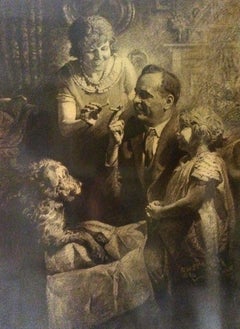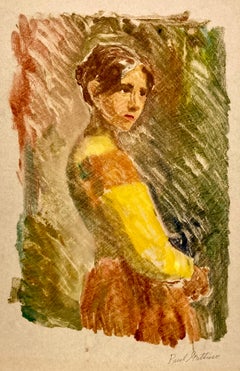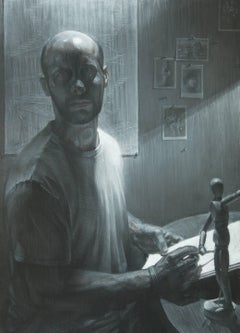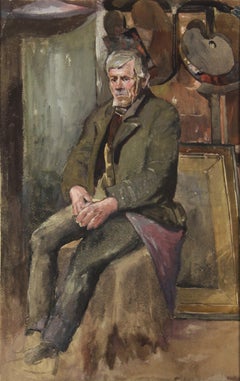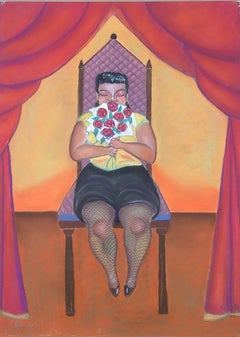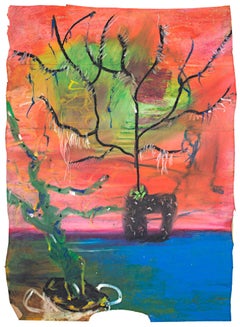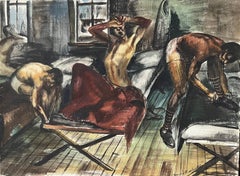Portrait Interior Drawings and Watercolors
to
1
1
2
2
2
1
Overall Width
to
Overall Height
to
1
5
2
1
1
1
1
2
7
1
24,231
456
239
165
151
136
92
91
62
56
56
52
48
42
41
35
34
30
28
22
3
3
3
2
2
2
1
1
1
3
7
1
Art Subject: Portrait
Father Smoking a Cigarette Surrounded by Family
Located in Fort Washington, PA
Medium: Charcoal on Board
Signature: Signed Lower Right
Category
20th Century Interior Drawings and Watercolors
Materials
Charcoal, Board
Paul Gattuso, (Young Woman)
Located in New York, NY
Paul Gattuso attended the Art Students League and worked primarily in New York City. There is an old address with a Bronx, Grand Concourse address.
Gattus...
Category
1930s Ashcan School Figurative Drawings and Watercolors
Materials
Monotype
Chiaroscuro
Located in Chicago, IL
-ARTIST STATEMENT-
I depict my person in multiplicity with different selves representing dramatis
personae. My likeness is both implicit and symbolic in the portrayal of my
narrative; the drama involved in creating art and the artist’s role in society. I
use realism to invite the viewer into mysterious inner worlds that are layered
reflections of the outer. Dehumanizing environments are imbued with art
historical references as a critique of power structures. The artist is an
Everyman who is at odds with society and his self.
Visually my work is a celebration of society’s dark undercurrents and its
overlooked absurdities. I use charcoal and printmaking media as their
tenebrous values add a fitting metaphor. The nuances of light and shadow
seduce viewers into a world their better judgment would have them avoid.
This provokes a sense of disquietude that causes viewers to assess our world
through the austerity of a colorless, yet not humorless, light.
-BIO-
Christopher Ganz grew up in Northeast Ohio and from early on had a fertile imagination and an interest in art. Christopher's artistic education truly began at the University of Missouri, where his love of the human form led to many figure drawing classes and his exposure to the wonders of printmaking. Christopher's then went onto graduate school at Indiana University and a summer abroad program in Italy was a dream realized. Christopher then grasped charcoal with a renewed vigor and large, sfumato-laden drawings ensued. Christopher's artistic influences are many; from a seminal exposure to Dore's engravings of the Divine Comedy, to Rembrandt, Caravaggio, Goya, and up to Lucian Freud, Mark Tansey...
Category
21st Century and Contemporary Contemporary Figurative Paintings
Materials
Chalk, Charcoal, Oil Pastel, Archival Paper
Man sitting in the studio - Thinking about art -
Located in Berlin, DE
Adolph Eduard Otto von Faber du Faur (1828 Ludwigsburg - 1901 Munich). Man sitting in the studio. Watercolour painting, 43 x 27 cm (visible size), 73 x 53 cm (frame), monogrammed at lower right, estate stamp.
Upper right corner neatly repaired, small tear in the wall to the left of the sitter.
- Thinking about art -
About the artwork
The sitter, an elderly man, is seated in a studio on a pedestal reminiscent of an academy hall. The earthy, dark tones give the scene a weighty quality. The lightest tones are found in the incarnate parts of the figure, which do not stand out from the other colours of the picture, but are linked to them. As a result, the sitter's face is both part of and the highlight of the colour references in the picture. The colour of the sitter's skin is reflected in his pink coat, while his white-grey hair matches the colour of the wall next to him. This almost monochrome wall surface, in turn, is connected across the portrait to the framed picture standing on the floor, which seems to have been erased by this correspondence with the empty wall surface. Through the palette, which is positioned directly behind the sitter's head, the reference to painting, which is already given by the studio space, is explicitly linked to the sitter, who thus seems to be contemplating the question of the meaning of art.
This raises the question of whether Faber Du Faur, who had become lonely in his old age, might have painted a self-portrait here in his later years. In addition to the studio setting, the sitter's explicit reference to the palette and the fact that the picture was part of his estate, the only summary elaboration of the body suggests a self-portrait, while the representation of the face is concretised with the wide-open eyes typical of a self-portrait. This concentration on the face gives the impression of the artist's melancholy introspection, captured by the palette and related to the meaning of painting, whose dark character is reinforced by the concealment of the palette hanging on the right of the picture in the light tones so characteristic of Faber Du Faur. In the course of this resignation, Faber du Faur advises his son Hans, who has also become a painter: "Promise me one thing: never move to Munich, they'll kill you here!"
Whoever the sitter may be, the references to painting make the portrait a resigned self-contemplation by Faber Du Faur, focused on art.
About the artist
After leaving school, Otto Faber du Faur entered the service of the Württemberg army, at the same time cultivating his artistic talent. In 1851, on the recommendation of his father Christian Wilhelm, who was himself a battle painter, he spent six months in Munich as an apprentice to Alexander von Kotzebue. In 1852 he was granted a year's leave of absence from military service to study battle painting in the studio of Adolphe Yvon...
Category
1890s Realist Portrait Drawings and Watercolors
Materials
Watercolor
$897 Sale Price
20% Off
small woman on a big chair, figurative, colorful, botero-like, pastel, paper
Located in Brooklyn, NY
Stephen Basso's highly original pastels and oil paintings are romantic, yet thought provoking fantasies. His whimsical works are alive with boundless imagination, wry wit and fear...
Category
1980s Outsider Art Figurative Drawings and Watercolors
Materials
Pastel, Archival Paper
Untitled
Located in Fort Washington, PA
Medium: Charcoal Drawing
Signature: Signed Lower Right
Framed 40.00" x 32.00"
Bad glare in photos taken. Piece is in perfect condition. Please let me know if you would like to see a...
Category
1910s Interior Drawings and Watercolors
Materials
Charcoal
"Cold Morning at Stone Creek, " Watercolor Cafe Interior by Julia Taylor
By Julia Taylor
Located in Milwaukee, WI
"Cold Morning at Stone Creek," an original watercolor by Julia Taylor. Stone Creek is a Milwaukee coffee chain. Customers near the left are waiting in line or ordering their coffee. ...
Category
2010s Contemporary Interior Drawings and Watercolors
Materials
Watercolor
Baking Time
Located in Fort Washington, PA
Medium: Pastel on Paper
Signature: Signed Lower Left
Health Club Baking Powder
Category
1940s Interior Drawings and Watercolors
Materials
Paper, Pastel
Related Items
"Plush Orange Scene, " Interior Oil Pastel on a Paper Bag by Reginald K. Gee
Located in Milwaukee, WI
"Plush Orange Scene" is an original oil pastel drawing on a paper bag by Reginald K. Gee. The artist signed the piece on the back. It features two plants against an orange and blue b...
Category
1990s Contemporary Interior Drawings and Watercolors
Materials
Oil Pastel
$1,950
H 16.5 in W 11.75 in
"Men in Barracks" WPA Mid 20th Century American Scene Realism Gay Modernism WWII
Located in New York, NY
"Men in Barracks" WPA Mid 20th Century American Scene Realism Gay Modernism WWII. 18 x 24 inches Watercolor on paper. c. 1940s. Signed lower right.
BIO
...
Category
1940s American Realist Figurative Drawings and Watercolors
Materials
Paper, Watercolor
Paris modernist scene mixed media drawimg
Located in Barcelona, Barcelona
Joan Cardona Lladós (1877-1957) - Modernist Paris scene - Mixed media (charcoal and white wax).
Drawing measurements 40x29 cm.
Frame measurements 66x54 cm.
He was born in Barcelona on June 30, 1877, he was registered with the name of Juan Bautista José Pedro. His parents Josep Cardona i Farré (Sant Salvador, 1852-Barcelona, ?) and Maria Lladós i Vidal (Isona, 1855-Barcelona, 1935) came from Sant Salvador de Toló and Isona, respectively, two towns very close to Tremp, in the Pallars Jussà region, close to the Lleida Pyrenees. The Cardona Lladós family was of humble origins, linked to the rural and peasant world. José Cardona and María Lladós married around 1876, when they were twenty-five and twenty-one years old respectively. The couple decided to improve their precarious situation by moving to live in Barcelona.
In 1877 Joan Cardona was born in the family home, at 62 Mediana de San Pedro Street, in the Ribera neighborhood of Barcelona and very close to the Rec Comtal. Joan Cardona was the firstborn of three brothers. When he was six years old, his sister Consuelo was born (1883) and later his younger sister, María (1888), was born. Josep Cardona i Farré was a day laborer and lived at least until the birth of his third daughter, María, in 1888. Her death, for reasons unknown to us, would occur shortly after.
After the death of Josep Cardona, León Farré i Duró (Isona, 1867-Barcelona, 1932) became part of the family nucleus with his mother María Lladós, who took care of the child Cardona and his sisters Consuelo and María.
Farré learned to play the guitar and was the most extraordinary disciple of the composer and guitarist Francesc Tàrrega i Eixea (Vila-real, 1852-Barcelona, 1909). Joan Cardona had in her stepfather the man who instilled in her a special musical and artistic sensitivity. The young Cardona took classes at the Academia Baixas, inaugurated in 1892 by the painter Joan Baixas i Carreter and installed on Carrer del Pi, a private center where a good batch of leading Catalan Modernisme artists were trained.
Cardona married Clemencia Parade Cazabat at the beginning of the century. Daughter of Carles Parade and Amara Cazabat, she was born in 1870 in Bagnères de Bigorre...
Category
1890s Modern Figurative Drawings and Watercolors
Materials
Mixed Media
$7,087 Sale Price
40% Off
H 15.75 in W 11.42 in
L V Guirand de Scevola (1871-1950) A Man writing at his desk , Signed pastel
Located in Paris, FR
Lucien-Victor Guirand de Scevola (1871-1950)
A Man writing at his desk, 18th century interior scene
Pastel on paper
Signed upper right
20.5 x 15.8 cm
Framed under glass : 37 x 31.5 cm
It is known that Guirand de Scevola was very interested in the Palace of Versailles and its Old Regime atmosphere, that he often painted it and that he participated in the Versailles Revival movement at the beginning of the century. This probably led him to paint scenes in the 18th century style, for which he was particularly well known and which are still sought after.
What is striking is the modernity of the execution of our pastel, which obviously contrasts with its subject in the style of the 18th century. Guirand de Scevoal is a great colourist and he proves it here with eclat, by building up his composition with white pastel highlights, contrasting with brown and black. There is something of the northern painters in this treatment of light. All this, as always with him, is very subtle. The light radiating from the window is almost an abstract notation, but it gives meaning to this interior scene.
Lucien-Victor Guirand de Scévola ( 1871 – 1950) was a French painter.
He was student of Fernand Cormon and Pierre Dupuis...
Category
1920s Art Deco Interior Drawings and Watercolors
Materials
Pastel
Alley. 1961. Paper, watercolor, 42x29.5 cm
Located in Riga, LV
Alley. 1961. Paper, watercolor, 42x29.5 cm
Dzidra Ezergaile (1926-2013)
Born in Riga. School years alternate with summer work in the countryside. In ...
Category
1960s Realist Landscape Drawings and Watercolors
Materials
Paper, Watercolor
'Historic English Chapel Interior, ' by Unknown, Watercolor Painting
Located in Oklahoma City, OK
This framed and matted 16" x 19" watercolor painting by an Unknown artist depicts an historic English chapel interior. The interior of the church features the large stained glass window pane...
Category
19th Century Realist Interior Drawings and Watercolors
Materials
Watercolor
$400 Sale Price
20% Off
H 16 in W 19 in D 1 in
Church Interior
By Ray Quigley
Located in Buffalo, NY
A modern illustration by American artist Ray Quigley depicting two men inside of a church.
Category
1950s Realist Figurative Drawings and Watercolors
Materials
Gouache, Illustration Board, Ink
Landscape. Paper, watercolor, 42x30 cm
Located in Riga, LV
Landscape. Paper, watercolor, 42x30 cm
Dzidra Ezergaile (1926-2013)
Born in Riga. School years alternate with summer work in the countryside. In 1947...
Category
1970s Realist Landscape Drawings and Watercolors
Materials
Paper, Watercolor
$89 Sale Price
20% Off
H 16.54 in W 11.82 in D 0.04 in
Cy Twombly with pink chairs. From the Interiors series
Located in Miami Beach, FL
A new series inspired by architecture, décor and stylish personalities of the world of interior design.
The worlds of fashion, society and pop culture are captured in the illustrati...
Category
21st Century and Contemporary Contemporary Interior Drawings and Waterco...
Materials
Paper, Gouache, Acrylic
$2,500
H 36 in W 24 in D 0.1 in
A Charming 1930s Charcoal Study of Three Young Men in a Lake House Window
Located in Chicago, IL
A Charming 1930s Charcoal Study of Three Young Men in a Lake House Window by Noted Chicago Modern Artist, Harold Haydon (Am. 1909-1994). Most likely completed during the summer mont...
Category
1930s American Modern Figurative Drawings and Watercolors
Materials
Paper, Charcoal
$345
H 12 in W 16 in D 0.25 in
The Open Window - 19th Century British Children's Book illustration by Sowerby
Located in London, GB
JOHN GEORGE SOWERBY
(1849-1914)
Phoebe - The Open Window
Watercolour heightened with white
Unframed, in mount only
8 by 7 cm., 3 by 2 ¼ in.
(mount size 25.5 by 20 cm., 10 by 8 in.)
Reproduced:
J G Sowerby & Thomas Crane, At Home, Marcus Ward & Co, 1881, p.42.
The current work was reproduced in Sowerby and Crane’s 1881 children’s book, At Home, where is accompanied by the following verse:
All the morning, all the morning,
Sat she till her tasks were done;
While without were birds and blossoms,
And the pleasant sun.
And the leaves in ev’ry rustle,
And the birds in ev’ry song:-
“Phoebe, Phoebe, are you coming?
Phoebe, don’t be long!”
Whispered thro’ the open window
Gentle breezes, passing by:-
“Phoebe, are you coming, Phoebe?
Come before we die!”
Till the clock, with joyful measure,
Struck the hour when work is o’er;
Crying “Ponto’” Phoebe vanished
Through the open door.
Whither sped out nimble Phoebe?
She is in the study now;
Ponto heard her with she called him, -
Answered back “Bow-wow!’
“Ponto, tho’ the birds and garden,
Called me all the morning thro’
I had first to do my lessons –
So I think should you.”
Poor old Ponto! He is longing,
Longing for his game of play,
And the garden – ah: but Phoebe
Has a word to say.
“Beg then – beg, sir – do you hear me?
No, no, Ponto, that is wrong;
Paws up! Steady! Ah, that’s better!
Good dog, come along!”
John George Sowerby was born into a prosperous Gateshead family of glass manufactures and artists. He inherited the family business, the Ellison Glass Works, one of the world’s largest producers of pressed glass, where he introduced designs inspired by the Arts and Crafts movement. Initially he combined his energies at the glass works with his work as an illustrator and painter of landscapes and floral subjects with a Pre-Raphaelite intensity, strong colours and rich detail. He exhibited many of these paintings at the Royal Academy. In the 1880s he collaborated with Newcastle artist, Henry Hetherington Emmerson, on illustrations for the children’s books Afternoon Tea (1880) and The May Blossom (1881). Although were critically very well received but the publications were attacked by Kate Greenaway who considered them too close to her own work. Sowerby then went on to produce highly aesthetic illustrated books At Home (1881) and At Home Again (1883), with decorations by Thomas Crane. Gleeson White, editor of The Studio magazine stated that in Afternoon Tea Sowerby “set a new fashion for ‘aesthetic’ little quartos’ (The Studio, 1897). Roger Dixon in Belfast Publishing (Oxford University Press, 2011, p.79) considered these At Home and At Home Again to be “among the loveliest books ever produced.” Never very wise as a business man, in the early 1880s he left Ellison Glass Works being declared bankrupt in 1884. He returned to the works again as a paid employee.
Sowerby’s daughter, Millicent Sowerby...
Category
Late 19th Century Realist Interior Drawings and Watercolors
Materials
Watercolor
Chicago Modernist Line Drawing Reclining Nude WPA Artist. Exhibited Work
Located in Surfside, FL
Reclining Nude.Early modernist line drawing, by American artist William S. Schwartz, c. 1940, gouache painting, signed with initials, framed. (size includes frame). Work is reminisce...
Category
Mid-20th Century American Modern Nude Drawings and Watercolors
Materials
Paper, Charcoal
William S. SchwartzChicago Modernist Line Drawing Reclining Nude WPA Artist. Exhibited Work, c. 1930
$1,100
H 14.25 in W 16.25 in D 0.1 in
